I was so thrilled because my brother Barry decided that he wants to keep bees. He came to Atlanta for the Short Course in January and went home and ordered equipment. He knows a commercial beekeeper in Natchez, MS where he lives and is getting bees from that man.
I went to Natchez this past weekend to help Barry put his equipment together. I had a great time and didn't take nearly enough pictures, but here's an overview.
We built and painted ten medium hive boxes. I took him two deeps because I believe the man from whom he is getting the bees will be expecting him to have deeps and not medium boxes. So we painted those as well. We also painted screened bottom boards, slatted racks, telescoping covers.
Barry single-handedly built 79 frames (one of the 80 broke!) The Walter Kelley jig for frame assembly is a convenience that I never want to be without. It was so much more efficient to build frames with this jig. Took a little getting used to - we goofed twice and had to take the frames apart to get them out of the jig. Barry became a master of the jig, though, in the end.
We then put wax foundation in all his frames and I set up the two basic hive boxes to show him how to do it. I also showed him how to hang the frame rack on the side, how to remove the second or seventh frame when you first open the box.
He had fun the whole time, but he really smiled when I showed him how to light the smoker.
I hope he will love the bees the way I do and will get into the zen of beekeeping!
This is the tale that began in 2006 in my first year of beekeeping in Atlanta, GA. ...there's still so much to learn.
Welcome - Explore my Blog
I've been keeping this blog for all of my beekeeping years and I am beginning my 19th year of beekeeping in April 2024. Now there are more than 1300 posts on this blog. Please use the search bar below to search the blog for other posts on a subject in which you are interested. You can also click on the "label" at the end of a post and all posts with that label will show up. At the very bottom of this page is a list of all the labels I've used.
Even if you find one post on the subject, I've posted a lot on basic beekeeping skills like installing bees, harvesting honey, inspecting the hive, etc. so be sure to search for more once you've found a topic of interest to you. And watch the useful videos and slide shows on the sidebar. All of them have captions. Please share posts of interest via Facebook, Pinterest, etc.
I began this blog to chronicle my beekeeping experiences. I have read lots of beekeeping books, but nothing takes the place of either hands-on experience with an experienced beekeeper or good pictures of the process. I want people to have a clearer picture of what to expect in their beekeeping so I post pictures and write about my beekeeping saga here.Master Beekeeper Enjoy with me as I learn and grow as a beekeeper.
I began this blog to chronicle my beekeeping experiences. I have read lots of beekeeping books, but nothing takes the place of either hands-on experience with an experienced beekeeper or good pictures of the process. I want people to have a clearer picture of what to expect in their beekeeping so I post pictures and write about my beekeeping saga here.Master Beekeeper Enjoy with me as I learn and grow as a beekeeper.
Need help with an Atlanta area swarm? Visit Found a Swarm? Call a Beekeeper. (404) 482-1848
Want to Pin this post?
Showing posts with label foundation. Show all posts
Showing posts with label foundation. Show all posts
Tuesday, March 02, 2010
Saturday, January 09, 2010
What You Need to Get Started in Beekeeping
My brother Barry wants to be a beekeeper and I promised him a list of the basics he would need. I decided to post it here for any of you who are curious to get started.
Here's the list - then you'll find descriptions of my thoughts behind it. This is my list and how I would do it if I were starting this year. There are all kinds of points of view and mine is not the only one. I am particularly biased about some beekeeping issues, as you who follow this blog already know!
Basics:
Good beekeeping book
Protective clothing: A bee suit (or long sleeved shirt, pants) and gloves
Hive equipment:
10 medium 8 frame hive boxes
80 frames to fit the medium boxes
Sheets of wax foundation for the frames
2 Telescoping covers for 8 frame equipment
2 inner covers or 2 ventilated inner covers for 8 frame equipment
2 screened bottom boards for 8 frame equipment
2 slatted racks for 8 frame equpiment
A smoker and something to use to light it (lighter, matches, whatever)
A hive tool (preferably 2 - they're cheap)
That will get you started. The descriptive list below includes some description and explanation as well as some extras to add to the basic list above.
************************************************************
Here are some suggestions:
Beekeeping for Dummies by Howland Blackiston
Natural Beekeeping by Ross Conrad
Hive Woodenware
Frames for the 10 boxes:
Each box takes eight frames. These also come unassembled. You'll need 80 frames. I don't use foundation at all any more, but starting out, you'll want to use foundation – wax, not plastic. There's a video/slide show on my blog about how to assemble frames. These frames have a groove in the bottom for the wax foundation and a wedge at the top to nail it into the frame.
Foundation for the frames – I would stick to pure wax. Brushy Mountain offers this. It's less expensive than Dadant for the same thing and if you are ordering your equipment from them, it all ships with one shipping charge. But you can get foundation from any bee company. People will tell you to use plastic, but I've now thrown out all of my plastic. The bees don't like it and wax is natural in the hive. In the end, you'll probably switch to foundationless, anyway, and let the bees build their own. Each hive needs a telescoping cover and an inner cover. You're going to be using 8 frame equipment, so be sure the inner cover and telescoping cover are for 8 frame equipment. Here is a telescoping cover and an inner cover.
Brushy Mountain (and others) make an English garden hive top – which is pretty to look at but not practical for an inspection – feel free to get it instead of the telescoping cover, if you would like. My friend Julia likes (and I want to order) the ventilated inner cover – great for the hot summers in the South. If you ordered it, you would not need the inner cover.
You'll also need a screened bottom board.
Ventilation is the issue in the heat of the summer. The screened bottom board helps with this as well as Varroa mite control. The ventilated inner cover would help as well.
I keep slatted racks (a place for the bees to hang out rather than waste their energy fanning the hive) on all of my hives. Brushy Mountain doesn't make them for 8 frame equipment. Betterbee does.
Smoker:This is an essential piece of beekeeping equipment and you'll use it a lot. Here's a basic one from Brushy Mountain. I rarely use mine except to let the bees know I'm coming by puffing one puff at the door. I don't think it's worth buying one of the fancier ones unless you plan to have so many hives that you'll need to relight it a lot.
Propane lighter: Available at any hardware store (I can't find a picture, but I put one in everyone's stocking for Christmas – cheap and useful)
Hive Tool Another essential piece of beekeeping equipment – buy two so you can always lay your hands on one of them.
Helpful Things to Have that aren't Essential:
Here's the list - then you'll find descriptions of my thoughts behind it. This is my list and how I would do it if I were starting this year. There are all kinds of points of view and mine is not the only one. I am particularly biased about some beekeeping issues, as you who follow this blog already know!
Basics:
Good beekeeping book
Protective clothing: A bee suit (or long sleeved shirt, pants) and gloves
Hive equipment:
10 medium 8 frame hive boxes
80 frames to fit the medium boxes
Sheets of wax foundation for the frames
2 Telescoping covers for 8 frame equipment
2 inner covers or 2 ventilated inner covers for 8 frame equipment
2 screened bottom boards for 8 frame equipment
2 slatted racks for 8 frame equpiment
A smoker and something to use to light it (lighter, matches, whatever)
A hive tool (preferably 2 - they're cheap)
That will get you started. The descriptive list below includes some description and explanation as well as some extras to add to the basic list above.
************************************************************
The basics for the beekeeper (the elaborated list):
A good beekeeping book for beginners:Here are some suggestions:
Beekeeping for Dummies by Howland Blackiston
Natural Beekeeping by Ross Conrad
Protective Clothing:
A Bee suit – if not a bee suit plan to wear long pants, long sleeved shirt and a bee veil
Bee suit thoughts: It's hot inside a bee suit. You need one that you can stand to wear in the heat. The head gear is often a problem for me. My original suit is from Dadant and comes with a hard hat and veil. The hard hat is regulated by a head band that I hate because it never fits right and slips down over my eyes all the time.
The ventilated suit from Golden Bee (504-456-8805) is great in hot southern weather. I don't like the veil particularly – it relies on a headband to keep it centered and that doesn't work well for me, but the suit is cool (all ventilated material) and I can manage the head part. Also the mesh of the veil is painted white which is great for bees not bothering you but hard for someone else to see your face inside the suit. (Matters to me because I wear it for teaching inspections).
The ventilated suit from Golden Bee (504-456-8805) is great in hot southern weather. I don't like the veil particularly – it relies on a headband to keep it centered and that doesn't work well for me, but the suit is cool (all ventilated material) and I can manage the head part. Also the mesh of the veil is painted white which is great for bees not bothering you but hard for someone else to see your face inside the suit. (Matters to me because I wear it for teaching inspections).
A similar suit is made by UltraBreeze although their website says that at the moment they are not taking orders.
I love a hooded jacket that I have from Mann Lake that is great to throw on for a quick visit to the hives or to use when I'm not doing a full on inspection.
Gloves - Many beekeepers work without gloves, but I don't like being stung on my hands – it's inconvenient.
Gloves present their own problems. Most beekeeping gloves are big, making it awkward to grasp things in the hive well. When you order gloves, talk to the company from whom you are ordering to understand how their gloves are sized. If I am using leather gloves, I like the ones I FINALLY got from Dadant that are XXS and do fit.
However, I take pictures all the time I am in the hives and now prefer nitrile gloves because they allow me more dexterity. I have been stung through them (they are used by surgeons and are not supposed to be penetrable by a knife, but leave it to the bees!)
Glove possibilities: Dadant has these
My favorite nitrile gloves are 8 mil blue ones from Gemplers I'm not doing surgery so I reuse them (!) and the box of 50 lasts about 1 ½ bee seasons
My favorite nitrile gloves are 8 mil blue ones from Gemplers I'm not doing surgery so I reuse them (!) and the box of 50 lasts about 1 ½ bee seasons
Miscellaneous clothing items that I take with me to the beeyard:
A bandana (there are about 100 uses for the bandana in the world – several in the beeyard – if only to wipe your brow – but I use it to keep my Dadant helmet from slipping),
A lanyard that I hook my camera on around my neck,
I always wear tennis shoes and socks – the only time I have been stung on my foot by a bee was when I stepped on a dying bee in my house
Basic equipment needs:A lanyard that I hook my camera on around my neck,
I always wear tennis shoes and socks – the only time I have been stung on my foot by a bee was when I stepped on a dying bee in my house
Hive Woodenware
Enough for two hives – you should start with two hives – this way you have something to compare to when one hive seems off in some way. You also can kill one hive with over zealousness and let the other survive more on its own!
Most beginning beekeepers start with a deep and a medium box for brood and shallows for honey. This is the old way and if you are starting with nuc hives, unless you've made special arrangements, the nuc will be in a deep nuc box.
However, for switching frames back and forth between boxes and for many other advantages (weight when lifting, etc), I would encourage everyone to do all of their boxes as medium boxes. For two hives you need a minimum of 3 medium boxes per hive and probably a couple of extras for each hive in the event that your bees get going well enough to produce honey the first year. I would also encourage 8 frame boxes – much easier to lift and manage
This means you need 10 medium eight-frame boxes. I would order based on shipping prices for your area. Shipping costs can be as much as the cost of the equipment you are ordering. I like to order from Brushy Mountain Beekeeping because the shipping to Atlanta is less than most of the other companies, but I order from Betterbee which is in New York and Dadant which has a warehouse in Florida. There are many good bee companies and you may be able to find a local supplier from whom to get your equipment.
Here are 10 medium eight-frame boxes from Brushy Mountain.
Like I said, you can order them from any bee company. These come unassembled – you nail or screw them together – keep the sides right side up and the inside on the inside! They should be painted which is a good thing to do while you wait for your bees – the Oops cart at Home Depot is a good source of paint. I paint all of mine the same color and keep a large gallon of paint available to do so. There's a post on my blog showing how to assemble them.Frames for the 10 boxes:
Each box takes eight frames. These also come unassembled. You'll need 80 frames. I don't use foundation at all any more, but starting out, you'll want to use foundation – wax, not plastic. There's a video/slide show on my blog about how to assemble frames. These frames have a groove in the bottom for the wax foundation and a wedge at the top to nail it into the frame.
Foundation for the frames – I would stick to pure wax. Brushy Mountain offers this. It's less expensive than Dadant for the same thing and if you are ordering your equipment from them, it all ships with one shipping charge. But you can get foundation from any bee company. People will tell you to use plastic, but I've now thrown out all of my plastic. The bees don't like it and wax is natural in the hive. In the end, you'll probably switch to foundationless, anyway, and let the bees build their own. Each hive needs a telescoping cover and an inner cover. You're going to be using 8 frame equipment, so be sure the inner cover and telescoping cover are for 8 frame equipment. Here is a telescoping cover and an inner cover.
Brushy Mountain (and others) make an English garden hive top – which is pretty to look at but not practical for an inspection – feel free to get it instead of the telescoping cover, if you would like. My friend Julia likes (and I want to order) the ventilated inner cover – great for the hot summers in the South. If you ordered it, you would not need the inner cover.
You'll also need a screened bottom board.
Ventilation is the issue in the heat of the summer. The screened bottom board helps with this as well as Varroa mite control. The ventilated inner cover would help as well.
I keep slatted racks (a place for the bees to hang out rather than waste their energy fanning the hive) on all of my hives. Brushy Mountain doesn't make them for 8 frame equipment. Betterbee does.
Smoker:This is an essential piece of beekeeping equipment and you'll use it a lot. Here's a basic one from Brushy Mountain. I rarely use mine except to let the bees know I'm coming by puffing one puff at the door. I don't think it's worth buying one of the fancier ones unless you plan to have so many hives that you'll need to relight it a lot.
Propane lighter: Available at any hardware store (I can't find a picture, but I put one in everyone's stocking for Christmas – cheap and useful)
Hive Tool Another essential piece of beekeeping equipment – buy two so you can always lay your hands on one of them.
Helpful Things to Have that aren't Essential:
Frame Rack: Very helpful – especially if you are looking for the queen, trying to see the differences in the bees, taking photos – I obviously love mine, but everyone doesn’t use them.
Frame Grip I've always relied on my hands – I don't want to inadvertently squash bees – but I'm putting it on this list because almost every other beekeeper I know uses this. I just never got comfortable with it.
Bee Brush I use this a lot – especially when harvesting honey since I remove one frame at a time from the hive. If you are going for crush and strain honey, then this is essential.
Harvest Equipment (Hopefully you'll have a harvest!):
This is all I need for harvesting and filtering honey. I also use a sharp knife and some basic kitchen equipment. You'll also need jars, but that is your preference. What kind of honey your produce dictates what type of jar you use. You are going to be able to cut comb (the foundation you are ordering will allow crush and strain as well as cut comb honey) or produce chunk honey (comb in a jar of honey)
*********************************************
OK, I think that is what is needed (at least what I would need) to start beekeeping. This is my list and others out there will want to add or suggest other things. There are other items that you will find useful – a sifter from the kitchen for powdered sugar and a few other things that I carry in my bee basket, but you'll come up with what works for you.
You'll notice that I didn't put any medication or feeding systems on this list. I don't use any medications or poison of any kind in my hives. I also tend to feed with Ziploc baggies inside the hives. A Boardman feeder may be useful for water for the bees, but there are other ways to provide water. I also didn't put an entrance reducer – not going to be necessary in the hot South but would be in other parts of the country.
Note: I did this post in Word's blog post section and uploaded it from Word....never again. The margins are awful - many apologies!
Monday, April 16, 2007
Inspecting Mellona Today
In Mellona today, the combs in the medium were being drawn well and straight. You can see the bees festooning in the picture below. I didn't disturb the hive much because I only had a short time before I had to go to work. Also it was cold and I didn't want to freeze the bees - just wanted to make sure they were building straight comb.
This hive is in an old repainted deep box and the medium box where this picture was taken is also an old box. The frames they are using are old frames - you can see the comb remnants from last year in the bottom of the frame. I wonder if the smell of the old comb, etc is helping these bees draw straight comb.....

Here is an example of an almost-filled comb from that hive:

I took off the honey super shallow box that I added last week and looked in it to see if the bees were building comb yet. They had barely started. In addition, I had put a full sheet of SC foundation in a frame in the center of this shallow.
The bees had completely chewed out the foundation. I actually heard them doing it. While it was really cold I went out and listened to the sides of the hive - it's something that I like to do because the smells and sounds of the hive at work are just wonderful. I heard the sound of them crunching and wondered what it was. Now I know.
I didn't run that foundation top to bottom (cutting error), but it extended to about 1/8 inch from the bottom. For some reason they didn't want it there and chewed it off......SC foundation is really expensive and the cheap part of me felt resentful that they wasted it like that!
On Beemaster I asked about the chewed foundation and the reply was that they probably needed the wax in the box below and chewed it off to use it there. If I had waited a little longer before putting that box on, then they might have left it alone. I usually add a super or box when the box below has 7 - 8 frames drawn with only a couple to go. This time I added the super when they had only drawn 6 frames. I did this since the tulip poplar flow is on and it was going to be too cold to go into the hives over the past week. Of course if it's too cold to go in the hives, it's also too cold for the bees to fly so having the extra super was too early and not necessary.
I think the old saying is "Hoist by my own petard." No, I just looked it up on Wikipedia and actually that's not the correct expression because it means to be harmed by something you intended to harm someone else (as in being blown up by your own bomb).
Since I only LOVE the bees, no harm was intended. In my family when you push to get something done in a more than timely way, we say that we are "pushing the train out of the station," a phrase used in my grandmother's house when my mother was growing up. So I guess in putting the super on too early, I was pushing the train out of the station.

This hive is in an old repainted deep box and the medium box where this picture was taken is also an old box. The frames they are using are old frames - you can see the comb remnants from last year in the bottom of the frame. I wonder if the smell of the old comb, etc is helping these bees draw straight comb.....

Here is an example of an almost-filled comb from that hive:

I took off the honey super shallow box that I added last week and looked in it to see if the bees were building comb yet. They had barely started. In addition, I had put a full sheet of SC foundation in a frame in the center of this shallow.
The bees had completely chewed out the foundation. I actually heard them doing it. While it was really cold I went out and listened to the sides of the hive - it's something that I like to do because the smells and sounds of the hive at work are just wonderful. I heard the sound of them crunching and wondered what it was. Now I know.
I didn't run that foundation top to bottom (cutting error), but it extended to about 1/8 inch from the bottom. For some reason they didn't want it there and chewed it off......SC foundation is really expensive and the cheap part of me felt resentful that they wasted it like that!
On Beemaster I asked about the chewed foundation and the reply was that they probably needed the wax in the box below and chewed it off to use it there. If I had waited a little longer before putting that box on, then they might have left it alone. I usually add a super or box when the box below has 7 - 8 frames drawn with only a couple to go. This time I added the super when they had only drawn 6 frames. I did this since the tulip poplar flow is on and it was going to be too cold to go into the hives over the past week. Of course if it's too cold to go in the hives, it's also too cold for the bees to fly so having the extra super was too early and not necessary.
I think the old saying is "Hoist by my own petard." No, I just looked it up on Wikipedia and actually that's not the correct expression because it means to be harmed by something you intended to harm someone else (as in being blown up by your own bomb).
Since I only LOVE the bees, no harm was intended. In my family when you push to get something done in a more than timely way, we say that we are "pushing the train out of the station," a phrase used in my grandmother's house when my mother was growing up. So I guess in putting the super on too early, I was pushing the train out of the station.

I took a brief look into Bermuda - boy, those are angry bees in that hive. They growled discontentedly when I opened the inner cover, and buzzed at my veil. They have not begun work in the medium that I added last week. It's possible that the hive is queenless (by virtue of the anger and the buzz when I opened the box) so I'll give it a proper inspection later in the week. Although it is also possible that the hive is still gathering strength since it was so weak a month ago.
Wednesday, June 07, 2006
The case of the too-short honey foundation
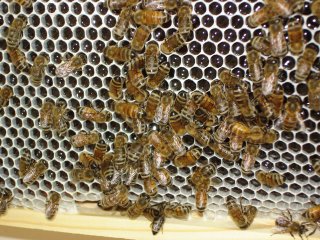 Remember earlier when I found that I had bought foundation that was too short for the frames I was building? I was curious to see how the bees adapted to my error. In this picture you can see that they have almost filled this frame with honey and have built comb to fill in the gap at the bottom.
Remember earlier when I found that I had bought foundation that was too short for the frames I was building? I was curious to see how the bees adapted to my error. In this picture you can see that they have almost filled this frame with honey and have built comb to fill in the gap at the bottom.
On a couple of the frames, they had made bulged out comb as you see here to fill the gap but in 20 frames in two supers, there were only two in which they did this bulge thing. Since I am using the crush and strain method to get my honey, the bulge will not create a problem. If I were using an extractor, it would be more difficult to uncap the honey when it is all curvy like this.

Friday, May 26, 2006
Housel positioning for the honey super
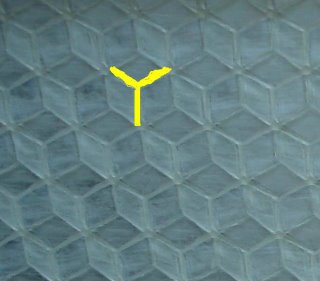 I’m interested in being a good landlord to my hives. If I am to do this, I should imitate nature as much as possible. Dee Lusby has written and spoken about a way to build the foundation for the bees to better imitate nature.
I’m interested in being a good landlord to my hives. If I am to do this, I should imitate nature as much as possible. Dee Lusby has written and spoken about a way to build the foundation for the bees to better imitate nature.In nature, the bees may hang a feral hive from a branch and build their comb out from there. When Michael Housel studied the feral comb, he found that the center of the cell has a “Y” in it. In natural comb on either side of the center the “Y” faces up toward the outside of the hive.
When foundation is in a frame, you can turn the frame from right to left and see the "y" facing up on one side and the "y" facing down on the other. Here's a link
to see the Y positions.
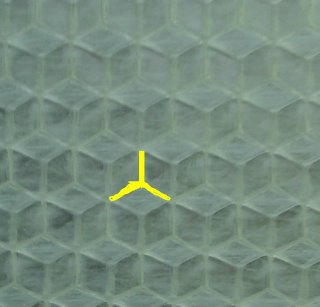
 When I added the super to Destin today, I marked the frames for Housel Positioning (HP) with an indicator of the "Y" up or down position. See how the up "Y" is on the outside from the center outward in each direction.
When I added the super to Destin today, I marked the frames for Housel Positioning (HP) with an indicator of the "Y" up or down position. See how the up "Y" is on the outside from the center outward in each direction.We'll see if the bees take to this more eagerly than they have with my previous random foundation placement

Friday, May 12, 2006
Honey in the beehive
I checked the hives before adding the super today. I found bees working hard to make and cap honey in the middle super of both Bermuda and Destin. Destin was fully drawn out (meaning that the bees took the wax foundation that I put in the frame and added wax to it to expand the depth of the comb) with honey in every frame except two and those were drawn out with wax, so I added a honey super to it.

The white capped wax at the top of the frame is over honey-filled cells. Some of the darker cells just below that are filled with pollen. The beige cells in the center and bottom are brood cells in which baby bees are being raised.
Bermuda continues to be slower and maybe not as strong. They had only worked on 6 of the 10 frames in their medium super, so I am waiting until about Monday to give them another super.
I also took away the sugar water feeders on both hives.


The white capped wax at the top of the frame is over honey-filled cells. Some of the darker cells just below that are filled with pollen. The beige cells in the center and bottom are brood cells in which baby bees are being raised.
Bermuda continues to be slower and maybe not as strong. They had only worked on 6 of the 10 frames in their medium super, so I am waiting until about Monday to give them another super.
I also took away the sugar water feeders on both hives.


Super Frames with too much space
I wish the smell of honeycomb could be transmitted through the Internet. The room where I've been working smells so full of honey.
I expect that making mistakes is part of being a "newbee" and I am certainly making plenty. This mistake is that I ordered the wrong size foundation for my frames.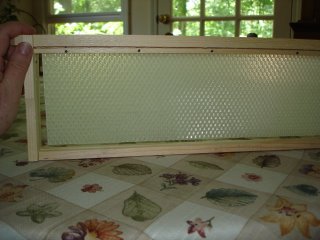 The foundation is supposed to sit in a slot at the bottom of this kind of frame but I ordered 4 3/8" foundation and needed a larger size. So the foundation is hanging by the top wedge and not connected to the bottom.
The foundation is supposed to sit in a slot at the bottom of this kind of frame but I ordered 4 3/8" foundation and needed a larger size. So the foundation is hanging by the top wedge and not connected to the bottom.
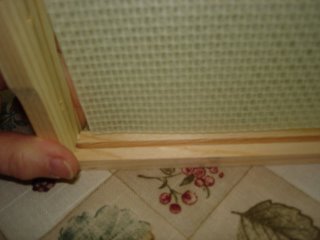
The bees should be fine with this - they'll make their own comb to fill the space. I'm planning to crush and strain the comb if I get any honey rather than using an extractor, so all of this should be fine, but I've been worrying about it - especially since I bought enough of this wrong size to fill five more supers - ARGHHHHHH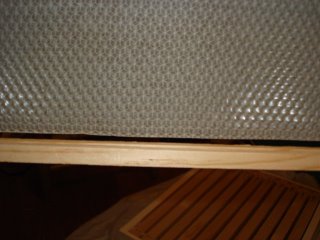 !!
!!
The amount of space between the bottom of the foundation and the bottom of the frame is only about 1/4" and if it hangs OK in the center of the frame, it ought not to bother the bees too much.
I expect that making mistakes is part of being a "newbee" and I am certainly making plenty. This mistake is that I ordered the wrong size foundation for my frames.
 The foundation is supposed to sit in a slot at the bottom of this kind of frame but I ordered 4 3/8" foundation and needed a larger size. So the foundation is hanging by the top wedge and not connected to the bottom.
The foundation is supposed to sit in a slot at the bottom of this kind of frame but I ordered 4 3/8" foundation and needed a larger size. So the foundation is hanging by the top wedge and not connected to the bottom.
The bees should be fine with this - they'll make their own comb to fill the space. I'm planning to crush and strain the comb if I get any honey rather than using an extractor, so all of this should be fine, but I've been worrying about it - especially since I bought enough of this wrong size to fill five more supers - ARGHHHHHH
 !!
!!The amount of space between the bottom of the foundation and the bottom of the frame is only about 1/4" and if it hangs OK in the center of the frame, it ought not to bother the bees too much.

Subscribe to:
Posts (Atom)
